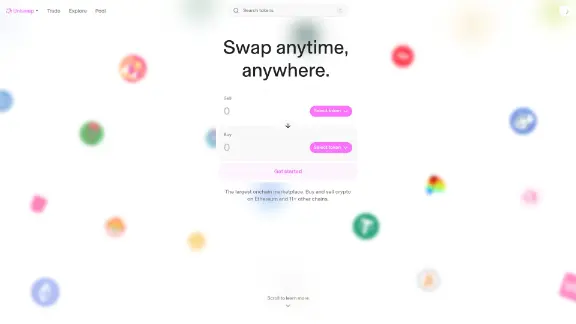Uniswap (UNI)
Uniswap is a decentralized exchange (DEX) protocol built on the Ethereum blockchain. It facilitates peer-to-peer trading of digital assets through automated market makers. The platform features a governance token, UNI, which allows users to engage in decision-making and earn rewards for providing liquidity.
Overview
Uniswap was founded on November 2, 2018, by Hayden Adams. Its permissionless design grants open access without selective restrictions. Utilizing smart contracts, Uniswap functions as an automated market maker, enabling digital asset trading via liquidity pools that rebalance automatically after each transaction. Users can create markets, swap assets, provide liquidity to earn UNI rewards, and participate in governance through voting. The open-source nature of Uniswap allows anyone to replicate its code and develop their own decentralized exchanges. It supports ERC-20 tokens and compatible infrastructure. Uniswap v2 operates on various blockchains including Arbitrum, Polygon, Optimism, Base, Binance Smart Chain, and Avalanche, offering users the ability to swap tokens and provide liquidity across these platforms.
UNI
UNI is the governance token for Uniswap, launched as an ERC-20 token in September 2020. It was distributed through an airdrop to users who participated in token swaps or provided liquidity.
UNI allocation
A total of 1 billion UNI were minted at genesis, with availability over four years. The allocation is as follows:

| Ticker | UNI |
| Category | Decentralized Exchange (DEX) |
| Website | https://uniswap.org/ |
| @Uniswap | |
| https://www.reddit.com/r/Uniswap | |
| Contract Addresses | |
|---|---|
| ethereum | 0x1f...84 Copied! Copied! |
| xdai | 0x45...74 Copied! Copied! |
| near-protocol | 1f...ar Copied! Copied! |
| optimistic-ethereum | 0x6f...91 Copied! Copied! |
| huobi-token | 0x22...e6 Copied! Copied! |
| arbitrum-one | 0xfa...f0 Copied! Copied! |
| polygon-pos | 0xb3...0f Copied! Copied! |
| harmony-shard-0 | 0x90...b6 Copied! Copied! |
| avalanche | 0x8e...80 Copied! Copied! |
| energi | 0x66...07 Copied! Copied! |
| sora | 0x00...8c Copied! Copied! |
| binance-smart-chain | 0xbf...b1 Copied! Copied! |
Liquidity mining
Uniswap initiated a liquidity mining program on September 18, 2020, running until November 17, 2020. During this period, liquidity mining incentives were provided to pools such as "ETH/USDT", "ETH/USDC", "ETH/DAI", and "ETH/WBTC". Each pool received 5,000,000 UNI, distributed in proportion to liquidity. This allocation resulted in approximately 83,333 UNI per pool per day for Liquidity Providers (LPs).
Timelock
The Timelock contract can modify system parameters, logic, and contracts using a ‘time-delayed, opt-out’ upgrade pattern. It enforces a minimum delay of 2 days for governance actions, with major upgrades potentially having up to a 30-day delay. The Timelock is controlled by the governance module, and actions can be monitored on the Timelock Dashboard.
Uniswap Grant Program
Proposed on December 3, 2020, by Jesse Walden and Ken Ng, the Uniswap Grant Program aims to provide resources to support Uniswap's ecosystem growth. It offers incentives, bounties, and infrastructure support to developers. The program has a quarterly budget of $750,000, reviewed every six months, and is managed by a committee of six members led by Ken Ng.
Evolution of Uniswap
Uniswap v2
Launched on March 23, 2020, Uniswap v2 serves as a decentralized marketplace for liquidity provision on Ethereum. It introduced ERC-20/ERC-20 pairs, allowing any ERC-20 token to be paired with another. This version features price oracles with time-weighted average prices (TWAPs), flash swaps without upfront costs, and a core/helper architecture for secure liquidity and trader usability. A protocol charge mechanism, hardcoded in core contracts, can adjust liquidity provider fees.
Uniswap v3
Released on March 23, 2021, Uniswap v3 focuses on improving automated market makers (AMMs) with "concentrated liquidity," enabling liquidity within specific price ranges for better capital efficiency. It offers multiple fee tiers (0.05%, 0.30%, 1.00%) and advanced oracles for precise price calculations. Liquidity providers can create multiple positions across price ranges to optimize capital.
Uniswap v4
Announced on June 13, 2023, Uniswap v4 introduces customizable liquidity through "hooks," allowing developers to create custom AMM pools. It features a singleton architecture for centralized pool management and native ETH support, reducing gas costs. Governance is community-driven, with code licensed under Business Source License 1.1.
UniswapX
Launched on July 17, 2023, UniswapX is a permissionless, open-source trading protocol enhancing onchain trading and self-custody swapping. It aggregates liquidity sources, employs a Dutch auction model for competitive pricing, and enables gas-free swapping. UniswapX addresses Maximal Extractable Value (MEV) issues and plans to expand into gas-free cross-chain swaps, offering enhanced flexibility and convenience. The protocol upholds security, self-custody, and community principles, providing an immutable smart contract.
